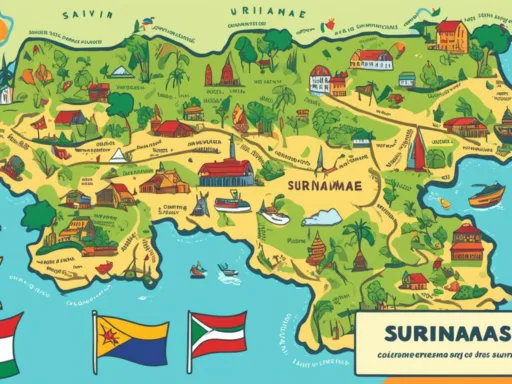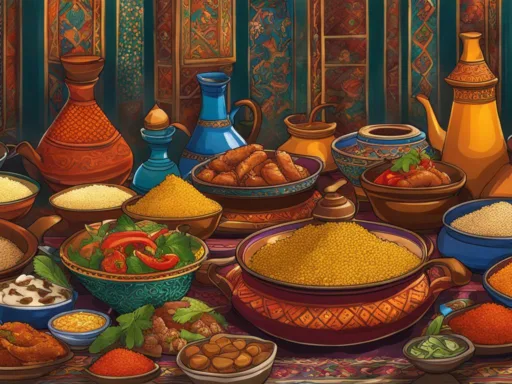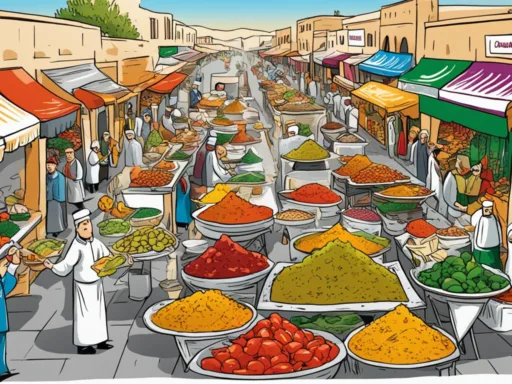Amidst the rugged, wind-swept landscapes of the North Atlantic, the Faeroe Islands boast a cultural richness as compelling as its natural beauty. This North Atlantic gem is home not only to scenic vistas but also a vibrant tapestry of language that underpins the life of its inhabitants. Central to this linguistic tapestry is the Faeroese language, an enduring echo of the medieval seafarers who charted these waters centuries ago.
The languages spoken in the Faeroe Islands reflect its history as a self-governing outpost within the Kingdom of Denmark. While Faroese, with its Old Norse lineage, serves as the heart-tongue of the islands’ communities, Danish marks its presence as the official second language. English and German also find their place, especially within the thriving tourism sector, attesting to the islands’ openness and adaptive spirit. Even the Danish QWERTY keyboard layout is adapted here to accommodate the unique Faroese characters, symbolizing a bridge between tradition and modernity.
Key Takeaways
- The Faeroese language is the national language of the Faeroe Islands, rooted in Old Norse.
- As an autonomous region of Denmark, the islands also hold Danish as an official language.
- English and German serve crucial roles in the tourism industry.
- The Danish QWERTY keyboard is custom-tailored to facilitate Faroese input, indicating technological adaptation to local culture.
- The unique blend of languages speaks to the Faeroe Islands’ historical depth and cultural openness.
The Linguistic Roots of the Faeroe Islands
The Faeroese language stands as a testament to the complex history and rich cultural tapestry of the Faeroe Islands. As the primary language among the languages spoken in the Faeroe Islands, its lineage can be traced back to the intrepid Norse settlers of the 9th century. Despite modern influences, the Faroese maintain a linguistic connection to their heritage, underscoring the resilience of the language amid the changing tides of history.

While Faeroese shares grammatical similarities with Icelandic and Old Norse, its pronunciation has veered closer to that of Norwegian, providing an intriguing glimpse into its complex linguistic roots. These intricate origins offer a narrative not just of a language, but of a people and their enduring connection to the past.
Origins of the Faeroese Language
The emergence of Faeroese, a language indigenous to the Faeroe Islands, is intimately linked to the first Norse settlers. These settlers from the 9th century introduced the West Norse language, which over time evolved and took on a form unique to these islands – a form we now recognize as Faeroese. This evolution marks an important chapter in the archipelago’s history, with the language serving as a living relic of the islanders’ venerable linguistic roots.
The Role of Old Norse and Irish Monks
It wasn’t just the Norse pilgrims who left their linguistic mark on the Faeroese landscape. The Old Norse language, carried to the islands’ shores by these Norse voyagers, intertwined with that of the Irish monks – known as papar – who are thought to have been among the first to step foot on the islands. The influence of these monks is subtly preserved in the place names and potentially in the Faeroese language itself, adding yet another layer to the rich tapestry of languages spoken in the Faeroe Islands and highlighting the multifaceted nature of the islands’ linguistic heritage.
Languages Spoken Faeroe Islands: A Detailed Overview
The Faeroe Islands, renowned for their stunning landscapes, are equally distinguished by the mosaic of languages spoken across the archipelago. This linguistic plurality is not just a means of communication but also an embodiment of the island’s diverse cultural identity. At the core of the language diversity are the Faeroese dialects, which resonate with the echo of Old Norse, their ancient progenitor, and form the linguistic lifeline for the majority of islanders.

As a testament to this language diversity, the latest figures highlight a robust linguistic landscape. Faroese, the tongue of the natives, is spoken by nearly 91% of the population as their first language. This prevalence underscores the enduring connection of the Faroese people to their heritage and the central role of their mother tongue in daily life.
Nonetheless, the linguistic panorama of the Faeroe Islands is far from monolithic. Danish, articulated not only in governance but also within educational institutions, remains a pivotal language, reflecting the Islands’ political association with Denmark. The essence of this European North Atlantic territory is further enriched by the presence of other languages, including Icelandic, English, and even linguistically distant tongues such as Filipino, Romanian, and Spanish. These languages mirror the subtle infusions of global influence and the archipelago’s openness to the wider world.
A deeper dive into the demographics of language usage reveals compelling insights:
| Language | Number of Speakers | Percentage of Population |
|---|---|---|
| Faroese | 45,361 | 90.8% |
| Danish | 1,546 | 3.1% |
| Icelandic | 201 | 0.4% |
| English | 190 | 0.3% |
| Filipino | 103 | 0.2% |
| Other Languages | Varies | Under 0.2% |
These statistics not only quantify the linguistic configuration but also capture the essence of language diversity in the Faeroe Islands. The prevalence of Faeroese dialects amidst this spectrum of languages creates a unique environment where ancient tongues and modern vernaculars coexist and complement one another.
It’s clear that the interplay of native and foreign languages fosters a cultural dynamism intrinsic to the Faeroe Islands—a place where language is celebrated as a bridge that connects its storied past with a cosmopolitan present.
Understanding the Faeroese Language
Positioned in the heart of the North Atlantic, the linguistic landscape of the Faeroe Islands is shaped by the Faeroese language, a unique member of the Scandinavian languages family. Within its cadences, the rich saga of the islands’ Norse heritage and its maritime culture are vividly brought to life. Faeroese, with its distinctive characteristics and structure, offers a fascinating study of linguistic evolution.

Comparing Faroese with Other Scandinavian Languages
The Faroese language astonishes linguists and language enthusiasts alike with its singular pronunciation and vocabulary that set it apart from other Scandinavian languages. While Faroese shares grammatical frameworks with Icelandic and Old Norse and bears a resemblance in written form due to a similar etymological orthography, it stands out in its phonetics. Pronunciation in the Faroese language is notably closer to Norwegian than to its Icelandic cousin, highlighting an intriguing divergence within the Scandinavian linguistic tree.
The Structure and Characteristics of Faeroese
The structure of Faeroese is a testament to its rich linguistic heritage, encompassing a complex phonological system characterized by palatalization and diphthongization. This system reflects the historical journey of the language, transitioning from Old Norse to the modern tongue spoken today. The phonology of Faeroese is particularly abundant in its vowel inventory, boasting an impressive array of 26 vowels, indicative of its nuanced acoustic range. The written script further complements this vocal complexity, utilizing an expanded Latin alphabet consisting of 29 letters.
These linguistic features underscore the Faeroese language’s position as a distinct dialect within the wider Scandinavian languages, while also emphasizing its pivotal role in the cultural identity of the Faeroe Islands. As both a repository of history and a thriving contemporary language, Faeroese dialects contribute to a dynamic and multi-faceted linguistic landscape that continues to evolve and enchant speakers and scholars.
The Status of Danish in the Faeroe Islands
While the heart of the Faeroe Islands beats with the poetic cadence of the Faroese language, the Danish language flows through its veins in the realms of governance and education. An intricate part of the Faeroese societal fabric, Danish has long held a duel role in the archipelago: as official language Faeroe Islands alongside Faroese and as a linguistic conduit to Denmark—both crucial for the islands’ administration and international liaisons.
Danish as an Official Language
The Danish language’s tenure as an official language in the Faeroe Islands is reflective of the isles’ historical ties with the Scandinavian region. Amicable yet authoritative, Danish provides the framework for official communication within the island’s public sector and for relations with the Danish authorities. Veering into the essence of Faeroese socio-political life, the use of Danish ensures that this North Atlantic society maintains robust ties with its continental counterpart.
The Educational Influence of Danish in Faeroese Society
The ripples of the Danish language’s influence in Faeroe Islands society are perhaps most palpably felt within its educational system. Aptly described as the second linguistic pillar, Danish underscores its presence from the very onset of schooling—right from the delicate stages of first grade education. The pedagogical approach here illustrates a balanced blend where Faeroese children are adeptly navigating their mother tongue while being proficient in Danish. Such bilingual competence stands as a testament to the integrative role of Faeroese education that appreciates both linguistic heirlooms and practical contemporaneity.
In sum, the symbiotic relationship of Faroese and Danish languages applies a gloss over the Faeroese cultural expanse, presenting a dichromatic tapestry worth admiration. From administrative documents to classroom instructions, the Danish language’s presence is a chorus harmonizing with the native vernacular—each an educational influence on the islanders’ daily dialogue.
FAQ
What Languages are Spoken in Faeroe Islands?
The primary language spoken in the Faeroe Islands is Faroese. It’s a North Atlantic gem, rich in cultural significance. Danish also holds official status and is taught in schools. Due to the international community and tourism, languages such as English and German are fairly common as well.
What is the Origin of the Faeroese Language?
The Faeroese language originated from Old Norse, the language spoken by Norse settlers during the 9th century. It has also been influenced by the early Irish monks, known as papar, which is evident in various place names across the islands.
How did Old Norse and Irish Monks Influence the Faeroese Language?
Old Norse, specifically from the West Norse dialect group, is the direct progenitor of modern Faroese. Irish monks, who are believed to have been amongst the earliest settlers, left linguistic marks through place names and possibly influenced the early development of the language. However, the extent of this influence on the Faeroese language itself is a topic still open for academic discussion.
How Diverse is the Linguistic Landscape of the Faeroe Islands?
Besides Faroese, the linguistic landscape in the Faeroe Islands includes a significant presence of Danish, followed by other languages like Icelandic, English, and lesser-spoken tongues such as Filipino, Romanian, and Spanish. This reflects the broad language diversity of the islands.
How Does Faroese Compare with Other Scandinavian Languages?
Faroese shares grammatical structures with Icelandic and Old Norse, but its pronunciation is more similar to Norwegian dialects. Despite the similarities in written form, Faroese and Icelandic are not mutually intelligible when spoken.
What are the Unique Characteristics of the Faeroese Language?
The Faeroese language stands out with its rich vocalic system featuring 26 vowels, and a phonological structure that involves diphthongisation and palatalization. The Faeroese alphabet, based on Latin script, comprises 29 letters that often differ in pronunciation from their written representation.
What is the Role of Danish as an Official Language in the Faeroe Islands?
Danish serves as an official language alongside Faroese in all aspects of public life, including administration, public services, and education. It facilitates official communication with Denmark and is an incremental part of the educational system in the Faeroe Islands.
How Does Danish Influence Education in the Faeroe Islands?
Danish has a significant educational influence in the Faeroe Islands. It is a mandatory subject taught from the first grade in schools, reflecting Denmark’s historical and ongoing ties with the islands. While Faroese is now the primary language in schools and official settings, Danish remains a key element of the islanders’ education.






